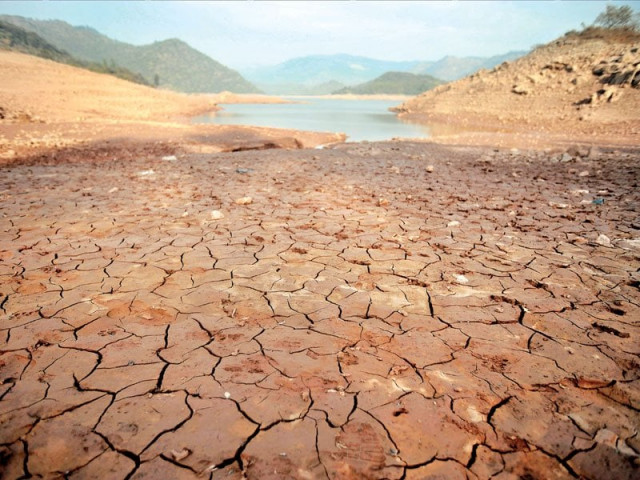Pakistan has gone from water surplus to water-stressed
Per capita availability has dropped from approximately 5,000 cubic metres to 1,000 cubic metres per year

Per capita availability has dropped from approximately 5,000 cubic metres to 1,000 cubic metres per year
PHOTO: FILE
Failure to estimate the actual water demand will hamper effective water management and overall socio-economic stability in Pakistan. Moreover, water resources (Indus River System) have potential to generate 59,000 megawatts of hydro energy in Pakistan.
The country has gone from being water-surplus to water-stressed and soon it is going to have water scarcity. The per-capita water availability has reduced from approximately 5,000 cubic meters per year to around 1,000 cubic meters per year.
Hospitals get clean drinking water
Of the 10% of water used in industries and for domestic use, the same pattern of wastage of water continues. Pakistan is expected to experience increased variability of river flows due to increased variability of precipitation and the melting of glaciers.
Demand for irrigation water may increase due to higher evaporation rates. Yields of wheat and basmati rice are expected to decline and may drive production northward, subject to water availability.
Water availability for hydropower generation may decline. Hotter temperatures are likely to increase energy demand due to increased air conditioning requirements.
Warmer air and water temperatures may decrease the efficiency of nuclear and thermal power plant generation. Mortality due to extreme heat waves may increase. Urban drainage systems may be further stressed by high rainfall and flash floods. Sea level rise and storm surges may adversely affect coastal infrastructure and livelihoods.
Furthermore, water also affects the health and well-being status of the population as poor quality of water is causing water-borne diseases, such as Diarrhea (23% under-5 children suffered from Diarrhea in 2013), etc. Around 70% of the rural population doesn’t have access to the safe drinking water, which means they are vulnerable to water-borne diseases.
In this regard, the government’s response towards these indicators is not very substantial. The country’s leaders are too distracted by extremism and political instability to focus on pressing environmental issues.
Response is defined as preparedness, but in Pakistan the extreme weather events are increasing; the super floods of 2010 affected around 20 million people in the country, and in 2011 five years of rainfall fell in just four weeks in Sindh. In 2012, there were more floods.
In Pakistan, climate change is a current reality with devastating consequences. The last few years of continuous flooding in the country has had a long-term impact on farmers’ ability to produce food. Instead of coming up with strong response and preparation to these events, the government is busy with their own issues of accountability.
According to the UNDP Pakistan, communities are working together to reduce the risk of flash floods in Northern Pakistan, particularly the floods caused by glacial lakes. These glacial lake outburst floods (GLOF) occur when the ice walls containing the reservoir fail, sending entire lakes down to inhabited areas below. Similarly, local communities improved livelihoods by repairing water channels in Sindh. They also mentioned that women earn income by repairing houses post floods.
In Pakistan, climate change in the form of heavy floods—due to Himalayan glacier melting—, droughts, and changing rain patterns—1500 mm in upper part of Pakistan—are adversely affecting the water resources that require effective planning and sufficient resource allocations to manage draining water resources. Pakistan had to face a loss of $9.6 billion in 2010 due to the climate change (CC) and the floods during 2010-2014 resulted in economic loss of $18 billion.
In the wake of the deteriorating condition of water availability, there is growing need to allocate more fiscal resources by both federal and provincial governments. Out of total Poverty Reduction Strategy Paper (PRSP) expenditures (FY2016-17), around 2.4% portion was spent on water supply and sanitation, including federal and provincial PRSP expenditures.
Comparing provincial PRSP expenditures on water supply and sanitation, Sindh has 18% reduction in the water budget in FY2016-17 compared to FY2015-16. Moreover, utilisation of allocated budget for water projects is not satisfactory as around 24% under-utilisation of budget in Punjab was reported in FY2016-17 and delayed release of funds is one of the major reasons of this under-utilisation.
Delay in the Diamer-Bhasha dam due to the unavailability of financial resources is another example of the inappropriate allocations for water related projects.
Awareness must be necessary in order to minimise deceptive and unsustainable activities, such as the use of stony water for washing cars or irrigation of lawns and gardens. Each of us must understand that less water usage means less wastewater production. Water supply agencies should install meters to charge consumers based on ‘pay as you use’. In such interventions, departments like WASA and CDA can play a major role. There is also a need to increase the percentage of budget allocation-to-GDP for the improvement of water and sanitation in the country.
Toxic water in Punjab's Kot Asadullah village infamous for causing deformities
If immediate action is not taken to address these issues, the amount and quality of the remaining water will have a negative impact on health, education and economic sectors.
The Environmental Protection Agency (EPA) must ensure, before discharging it to the mainstreams, and to improve the drainage network, ensuring higher sanitary coverage, ensuring household waste disposal, commercial and industrial units.
The writer is a researcher at the Sustainable Development Policy Institute
Published in The Express Tribune, May 14th, 2018.
Like Business on Facebook, follow @TribuneBiz on Twitter to stay informed and join in the conversation.



1728020501-0/Express-Tribune-Web-(13)1728020501-0-208x130.webp)















COMMENTS
Comments are moderated and generally will be posted if they are on-topic and not abusive.
For more information, please see our Comments FAQ